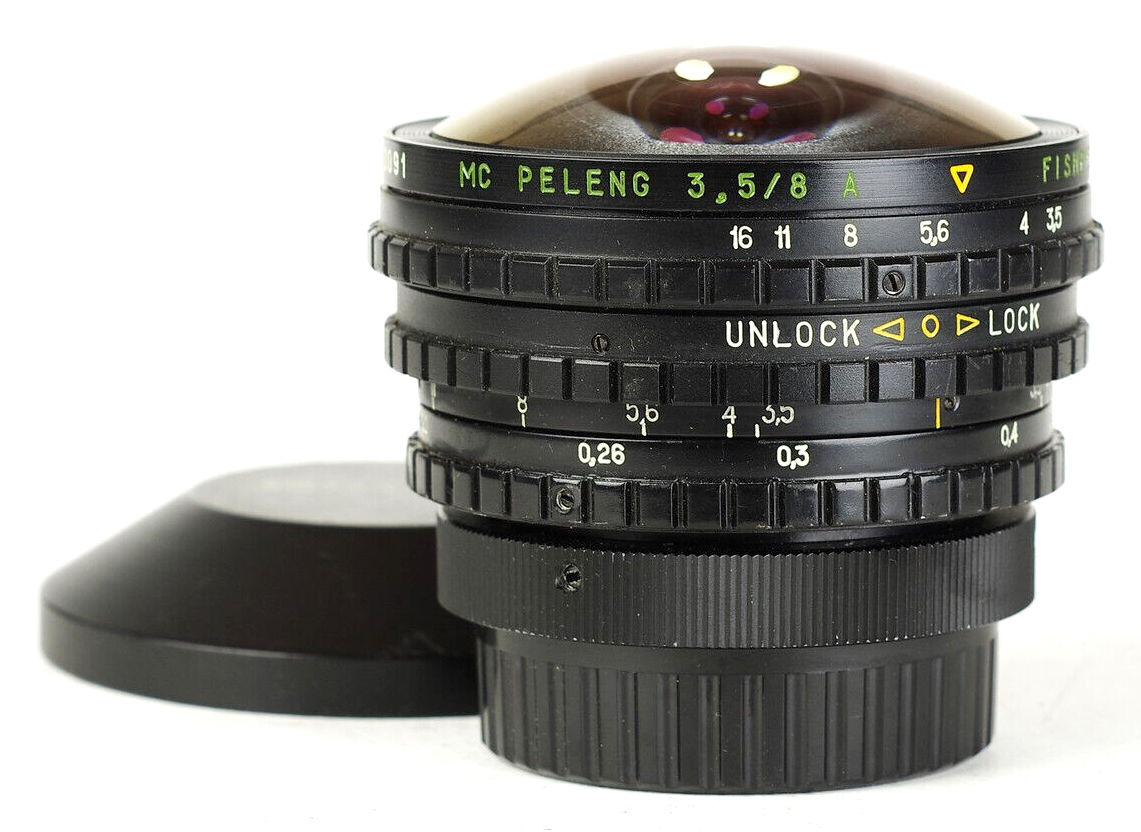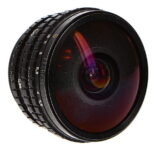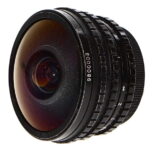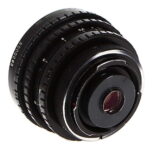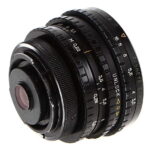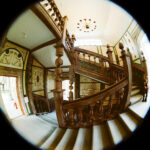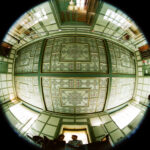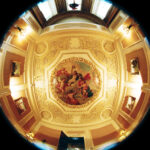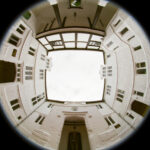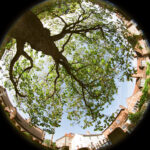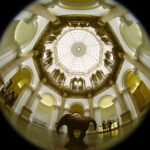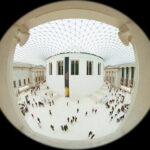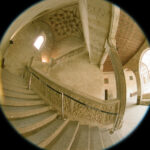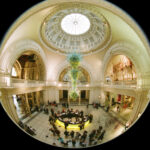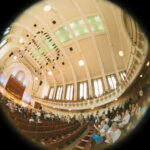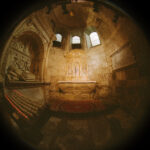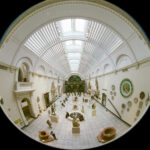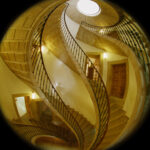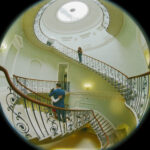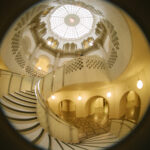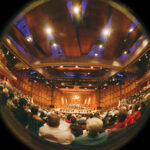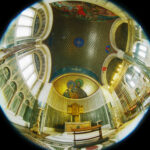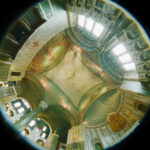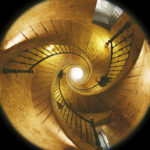BelOMO Peleng A 8mm F/3.5 Fisheye MC
Fisheye lens • Film era • Discontinued
- Announced:
- · No data
- Production status:
- ● Discontinued
- Country of design:
- · Belarus
- Original name:
- · MC PELENG 3,5/8 A FISHEYE CIRCULAR
- · BELOMO EWP FISHEYE LENS MC 3.5/8 A
- Class:
- · Slow full-frame circular fisheye lens
- · Professional model (Top class)
- System:
- · Zenit M42 (1965)
- · Kiev-17/19/20 (1978)
Abbreviations
| FISHEYE | An ultra-wide angle lens with strong uncorrected barrel distortion and extreme angle of view. |
| MC | Multi-layer anti-reflection coating is applied to the surfaces of lens elements. This anti-reflection coating increases light transmission, eliminates flare and ghosting, and maintains color consistence among all lens models. |
Sample photos (31)
Specification
| Optical design: | |
| 35mm full frame | |
| 8mm | |
| F/3.5 | |
| 11 elements in 6 groups | |
| Circular fisheye | |
| Interchangeable mount (T) | |
| 180° | |
| Diaphragm mechanism: | |
Diaphragm type: | Preset |
Aperture control: | Preset ring + Aperture ring |
| 9 (nine) | |
| Focusing: | |
| 0.22m | |
| <No data> | |
Focusing modes: | Manual focus only |
Manual focus control: | Focusing ring |
| Physical characteristics: | |
| 400g | |
| ⌀73.5×65.5mm | |
| Accessories: | |
| Removable front filters are not accepted | |
| Rear screw-type 30mm | |
| Not available | |
| <No data> |
Source of data
- Manufacturer's technical data.
Manufacturer description #1
MC Peleng 3,5/8A is an ultra-wide-angle fisheye circular lens with coated optics. A distinctive feature of the lens is a 180° field of view in all directions, which makes it possible to capture the entire front hemisphere of the object space on film.
The lens is supplied with adapters for use on various SLR cameras.
- for the "Zenit" camera, the "M42x1" adapter is used with the connecting thread M42x1 and a working distance of 45.5 mm;
- for "Kiev" cameras and Nikon digital and film camera, the "H" adapter with a working distance of 46.5 mm is used;
- for Canon digital and film cameras, the "EOS" adapter with a working distance of 44 mm is used.
The lens guarantees an unusual shooting, in the process of work it is able to place in the frame the objects that fascinated you so much, original natural landscapes, entire architectural ensembles, giving them a new look. By changing the usual proportions of objects, the lens allows you to achieve very unusual and impressive pictorial effects. The lens is also indispensable for shooting indoors. The image giving by the lens is a circle with a diameter of 24 mm, it occupies only a part of the 24x36 frame and is inserted into the small side of the frame. The geometric centers of the image and the frame coincide. The diaphragm is controlled manually. The lens has a pre-set aperture, which increases efficiency when photographing, and a set of interchangeable filters.
Light transmission: 0.7. Resolving power, mm: in the center: 55, at the edges: 15.
Manufacturer description #2
One of the basic advantages of 3.5x8a Lens is its appearance. The Lens has a pleasant and ergonomic design. Thanks to application of special technologies and special optical scheme it is rather light and compact.
The materials which are being applied for 3.5x8 Lens production - glass and metal, of course, demand care, but not such care as in case of application of plastic which is being very often applied by foreign manufacturers of the similar lenses. Our lenses can be used more efficiently than those made of plastic and will serve for longer period than plastic lenses. Quality of lenses will satisfy both the requirements of skilled amateur photographers, as well as a considerable part of the requirements of the strict professionals.
3.5x8a Lens is designed in minimalistic style for increase of reliability. It has all necessary components and nothing superfluous. It allows to fulfil all tasks. It deliberately does not contain electronic components, it is completely manual since in practice such type of lenses does not need electronic components in view of very small focal distances. Electronic components, certainly, increase convenience, but reduce the service life of the lens. As it is generally known, the less parts the device has, the less chances that something will be broken. We adhered to this concept in the course of development of the Lens. Electronic components account for approximately 30% of the parts of the Lens, accordingly the chances of breaking of the Lens in case of absence of electronic components decrease by 30 %.
Relative aperture "3,5" testifies of the sufficient lens aperture which allows to receive a light-coloured image in the viewfinder of the reflex camera and to perform photographing under low illumination conditions. In this respect the lens is not worse than the foreign analogues. Chromatic aberrations which are practically inevitable in similar optical systems are rather insignificant and are at the level of the foreign analogues. At that they can be easily corrected in the corresponding sections of Photoshop program.
The lens depth of field is rather great, however in practice there can be a deceptive impression that the scales of depth of field do not absolutely precisely correspond to the real image.
Light transmission: 0.7. Resolving power, mm: in the center: 55, at the edges: 15.
Typical characteristics of fisheye lenses
- Extreme angle of view (at least 180° diagonally);
- Circular types (the image circle of the lens is inscribed in the image frame) or diagonal types (cover the entire image frame);
- Usually of equidistant projection type, with the distance from the picture center to any given point always proportional to the angle from the optical axis to that point;
- Huge barrel distortion;
- Short closest focusing distance (0.20 - 0.30m with 35mm full-frame prime lenses);
- Very large depth of field, eliminating the need for autofocus or precise manual focusing;
- Due to the extreme angle of view and convex front element, front filters cannot be used;
- Often equipped with a filter turret with swivel-mounted filters;
- Often come with a small, built-in petal-shaped lens hood.
From the editor
The lens was produced by the Belarusian Optical and Mechanical Association (BelOMO) since the early 1990s under the name "MC PELENG 3,5/8 A", where "PELENG" (or "Пеленг", in Russian) means "azimuth". In recent years, it has been sold for export under the name "BELOMO EWP FISHEYE LENS MC 3.5/8 A". "EWP" probably means "Equidistant Wide-angle Projection"; this projection bends straight lines but saves angles.
Since the use of front filters is not possible due to the convex front element and the ultra wide angle of view, the lens accepts interchangeable 30mm filters that are screwed onto the rear element. Since the filter is part of the lens construction, one of the supplied filters must be installed before using the lens.
Notes
- The lens has an interchangeable mount that is mechanically identical to the T2 interchangeable mount. In the USSR, the following interchangeable mount adapters were produced: "КП-А/42" (T2 - M42x1/45.5), "КП-А/39" (T2 - M39x1/45.2), "КП-А/К" (T2 - Pentax K), "КП-А/Н" (T2 - Nikon F). "КП" is an abbreviation for "Кольцо переходное", which means "Adapter ring".
